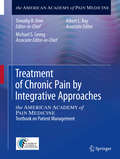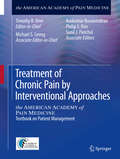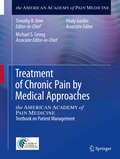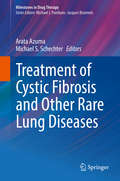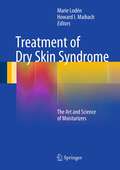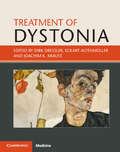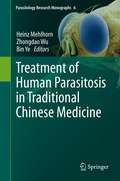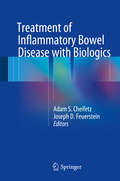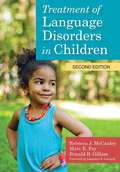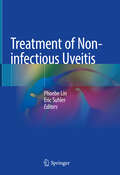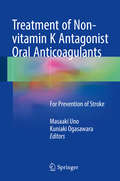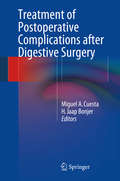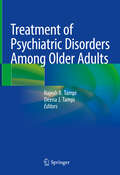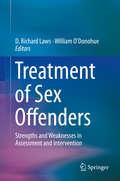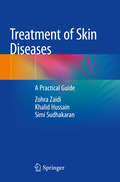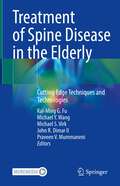- Table View
- List View
Treatment of Chronic Pain by Integrative Approaches
by Albert L. Ray Timothy R. Deer Michael S. LeongFrom reviews of Deer, eds. , Comprehensive Treatment of Chronic Pain by Medical, Interventional, and Integrative Approaches: "Comprehensive Treatment of Chronic Pain by Medical, Interventional, and Integrative Approaches is a major textbook. . . [I]t should be a part of all departmental libraries and in the reference collection of pain fellows and pain practitioners. In fact, this text could be to pain as Miller is to general anesthesia. " Journal of Neurosurgical Anesthesiology Edited by master clinician-experts appointed by the American Academy of Pain Medicine, this is a soft cover version of the Integrative section of the acclaimed Deer, eds. , Comprehensive Treatment of Chronic Pain by Medical, Interventional, and Integrative Approaches. It is intended as a primary reference for busy clinicians who seek up-to-date and authoritative information about integrative approaches to treating chronic pain. Behavioral dimensions of the experience and management of pain Integrative approaches for treating the "whole person" Legal issues, such as failure to treat pain First-hand patient accounts "Key Points" preview contents of each chapter
Treatment of Chronic Pain by Interventional Approaches
by Philip S. Kim Sunil J. Panchal Asokumar Buvanendran Timothy R. Deer Michael S. LeongFrom reviews of Deer, eds. , Comprehensive Treatment of Chronic Pain by Medical, Interventional, and Integrative Approaches: "Comprehensive Treatment of Chronic Pain by Medical, Interventional, and Integrative Approaches is a major textbook. . . [I]t should be a part of all departmental libraries and in the reference collection of pain fellows and pain practitioners. In fact, this text could be to pain as Miller is to general anesthesia. " Journal of Neurosurgical Anesthesiology Edited by master clinician-experts appointed by the American Academy of Pain Medicine, this is a soft cover version of the Interventional sections of the acclaimed Deer, eds. , Comprehensive Treatment of Chronic Pain by Medical, Interventional, and Integrative Approaches. It is intended as a primary reference for busy clinicians who seek up-to-date and authoritative information about interventional approaches to treating chronic pain. State-of-the-art coverage of full range of techniques: neural blockades, neurolysis blocks, and neurostimulation Review of clinically relevant anatomy and physiology "Key Points" preview contents of each chapter
Treatment of Chronic Pain by Medical Approaches
by Vitaly Gordin Timothy R. Deer Michael S. LeongFrom reviews of Deer, eds. , Comprehensive Treatment of Chronic Pain by Medical, Interventional, and Integrative Approaches: "Comprehensive Treatment of Chronic Pain by Medical, Interventional, and Integrative Approaches is a major textbook. . . [I]t should be a part of all departmental libraries and in the reference collection of pain fellows and pain practitioners. In fact, this text could be to pain as Miller is to general anesthesia. " Journal of Neurosurgical Anesthesiology Edited by master clinician-experts appointed by the American Academy of Pain Medicine, this is a soft cover version of the Medical section of the acclaimed Deer, eds. , Comprehensive Treatment of Chronic Pain by Medical, Interventional, and Integrative Approaches. It is intended as a primary reference for busy clinicians who seek up-to-date and authoritative information about medical approaches to treating chronic pain. Clinically focused resource on the medical management of chronic pain Leading edge topics, such as monitoring opioid use and abuse, the emerging role of cannabinoids in pain treatment, and the systems involved in nociceptive processing systems "Key Points" preview contents of each chapter
Treatment of Complex Trauma
by Julian D. Ford Christine A. CourtoisThis insightful guide provides a pragmatic roadmap for treating adult survivors of complex psychological trauma. Christine Courtois and Julian Ford present their effective, research-based approach for helping clients move through three clearly defined phases of posttraumatic recovery. Two detailed case examples run throughout the book, illustrating how to plan and implement strengths-based interventions that use a secure therapeutic alliance as a catalyst for change. Essential topics include managing crises, treating severe affect dysregulation and dissociation, and dealing with the emotional impact of this type of work. The companion Web page offers downloadable reflection questions for clinicians and extensive listings of professional and self-help resources. See also Drs. Courtois and Ford's edited volume, Treating Complex Traumatic Stress Disorders, which presents research on the nature of complex trauma and reviews a range of evidence-based treatment models for adults.
Treatment of Complex Trauma
by Julian D. Ford Christine A. Courtois John BriereThis insightful guide provides a pragmatic roadmap for treating adult survivors of complex psychological trauma. Christine Courtois and Julian Ford present their effective, research-based approach for helping clients move through three clearly defined phases of posttraumatic recovery. Two detailed case examples run throughout the book, illustrating how to plan and implement strengths-based interventions that use a secure therapeutic alliance as a catalyst for change. Essential topics include managing crises, treating severe affect dysregulation and dissociation, and therapist self-care. The companion website offers downloadable reflection questions for clinicians and extensive listings of professional and self-help resources. A new preface in the paperback and e-book editions addresses key scientific advances. See also Drs. Courtois and Ford's edited volumes, Treating Complex Traumatic Stress Disorders (Adults) and Treating Complex Traumatic Stress Disorders in Children and Adolescents, which present research on the nature of complex trauma and review evidence-based treatment models. Winner (Second Place)--American Journal of Nursing Book of the Year Award, Psychiatric and Mental Health Nursing Category
Treatment of Cystic Fibrosis and Other Rare Lung Diseases
by Arata Azuma Michael S. SchechterThis volume describes the pathogenesis and pathophysiology of several pulmonary diseases as well as their treatment. It also discusses the underlying genetic and molecular biological basis, which opens the way for new treatments for these conditions. It focuses on the treatment of cystic fibrosis including CFTR (cystic fibrosis transmembrane-conductance regulator) modulator therapies, drug therapies that augment airway surface liquid as well as anti-inflammatory and anti-infective therapies. Further topics include long-term, low-dose macrolide therapy for diffuse panbronchiolitis; novel agents for previously untreatable idiopathic pulmonary fibrosis; possible new treatments for pulmonary alveolar proteinosis (PAP); and multiple novel therapeutic targets for treating lymphangiomyomatosis. Research into these conditions has led to major advances in our understanding of the underlying genetic and molecular basis of this disease, and to dramatic improvements in survival and quality of life for affected individuals.
Treatment of Dry Skin Syndrome
by Howard I. Maibach Marie LodénDevelopment of moisturizers is a scientific and artistic discipline, where consumer insights are also needed. This new book bridges the gap between the moisturizers and the skin by covering all the essential information required to tailor the use of moisturizers to particular disorders and patients. Important aspects of skin biochemistry and barrier function are explained, and the ingredients and treatment effects of moisturizers are explored in depth. Careful attention is paid to controversies, including the role of certain moisturizers in inducing dryness/eczema, asthma, and comedones. The information provided in this unique book will enable the reader to go beyond the traditional thinking regarding skin care. The novel insights offered will suggest the properties required for a new generation of moisturizing treatments that more effectively improve the quality of life.
Treatment of Dystonia
by Dirk Dressler Eckart Altenmüller Joachim K. KraussOur understanding of dystonia is advancing rapidly. This comprehensive reference work provides an effective guide to this challenging group of disorders, offering an overview of the current and emerging treatment options for all manifestations. Treatments for the many forms of dystonia differ substantially in pediatrics and adults - both are covered in detail in this book. Approaches include botulinum toxin therapy, deep brain stimulation, oral drug applications, rehabilitation, and behavioral and experimental therapies. Special emphasis is also given to combining different treatment modalities in order to achieve optimal effect. Treatment of Dystonia brings together peer-reviewed articles, written by experts and based on work presented at international conferences. By enabling the physician to select and combine the best therapies, it is an essential resource for neurologists, neurosurgeons and physical therapists.
Treatment of Eating Disorders
by James Mitchell Carlos GriloEminently practical and authoritative, this comprehensive clinical handbook brings together leading international experts on eating disorders to describe the most effective treatments and how to implement them. Coverage encompasses psychosocial, family-based, medical, and nutritional therapies for anorexia nervosa, bulimia nervosa, binge-eating disorder, and other eating disorders and disturbances. Especially noteworthy are "mini-manuals" that present the nuts and bolts of 11 of the treatment approaches, complete with reproducible handouts and forms. The volume also provides an overview of assessment, treatment planning, and medical management issues. Special topics include psychiatric comorbidities, involuntary treatment, support for caregivers, childhood eating disorders, and new directions in treatment research and evaluation.
Treatment of Esophageal and Hypopharingeal Squamous Cell Carcinoma
by Giovanni De ManzoniSquamous cell carcinoma of the esophagus has a lower incidence than other gastrointestinal tract cancer; however, there are many difficult issued related to the choice of appropriate therapy for these patients. In recent years, the use of multimodal treatment has greatly improved the prognosis of patients affected by this disease but several aspects of the oncological and surgical management are still controversial. This book aims to give a homogeneous approach to esophageal cancer treatment, based on the author's lifetime experience in conjunction with exhaustive review of recent literature. In each chapter surgeons and oncologists will find appropriate tools for correct management of the diagnosis and therapy of this difficult disease. The book analyzes all the aspects of staging and treatment, such as modern diagnostic and staging techniques (MRI or PET-CT), endoscopic treatment of early cancer, new minimally invasive and open surgical techniques, and combined treatment. In addition, there are chapters dedicated to the postoperative course of these patients, as well as their quality of life, with indications for the correct follow-up and treatment of relapses.
Treatment of Fracture-Related Infection: An Orthoplastic Approach
by Nieves VanaclochaFracture-related infection is amongst the most challenging and complex conditions that physicians face all over the world. Treatment is complex and interdisciplinary, with scarce, low-quality evidence to aid decision-making. Successful management of fracture-related infection requires not only the combination of meticulous surgical treatment and pathogen-directed antimicrobial therapy, but also an in-depth understanding of the pathophysiology (including the role of biofilm), diagnostic methods, and the nuances of the advanced surgical techniques required. This book breaks down the decision-making involved in selecting and effectively performing a treatment strategy in patients with a fracture-related infection, with a keen focus on clinical relevance and applicability. Each chapter has been co-written by authors with different training (often, an orthopaedic and a plastic surgeon), as well as years of expertise in this evolving field, who present the decision-making process in an accessible way that can be immediately integrated into the physician&’s practice. Options for treatment are discussed based on each clinical scenario (state of the fracture, patient condition, and status of the soft tissue envelope), including indications of implant retention strategies (DAIR), amputation, options when the joint is unsalvageable (endoprosthetic replacement, arthrodesis, resection arthroplasty) or management of infected bone defects (acute shortening with or without re-lengthening, bone transport, bone grafts, bone flaps), with illustrative clinical cases at the end of the chapter. The workings and indications of the latest innovations, including molecular diagnostics, nuclear imaging, strategies to overcome resistant microorganisms, implants with antimicrobial surface modifications and compressive osseointegration, are discussed as well. Through multidisciplinary insights and actionable, practical strategies, this book equips readers with the knowledge needed to reduce infection rates, improve patient recovery, and ultimately deliver superior care. Orthopaedic and trauma surgeons, plastic surgeons, infectious disease specialists, and other components of teams dealing with bone infections associated to fractures will find this book of great value to enhancing patient outcomes, and a direct benefit to their practice.
Treatment of Human Parasitosis in Traditional Chinese Medicine
by Heinz Mehlhorn Zhongdao Wu Bin YeThis book intensively examines the efficacy of plant-derived products that have been used for over a thousand years by practitioners of so-called Traditional Chinese Medicine in the light of recent chemotherapeuticals. The chapters were written by renowned Chinese medical researchers and are supplemented by results obtained in German antiparasitic research projects. Parasites and emerging diseases are a major threat of our time, which is characterized by an enormous increase in the size of the human population and by an unbelievably rapid globalization that has led to the daily transport of millions of humans and containers with goods from one end of the earth to the other. Furthermore the slow but constant global warming offers new opportunities for many agents of diseases to become established in new areas. Therefore it is essential that we develop precautions in order to avoid epidemics or even pandemics in overcrowded megacities or at the large-scale farm animal confinements that are needed to secure a steady flow of food in the crowded regions of the world. Of course intensive research in the field of chemotherapy since 1900 has produced unbelievable breakthroughs in therapies for formerly untreatable and thus deadly diseases. However, a large number of untreatable diseases remain, as well as a constantly growing number of agents of disease that have developed resistances to standard chemical compounds. As such, it is not only worthwhile but also vital to consider the enormous amounts of information that have been obtained by human "high cultures" in the past. Examples from the past (like quinine) or present (like artemisinin, a modern antimalarial drug) show that plant extracts may hold tremendous potential in the fight against parasites and/or against vector-transmitted agents of diseases.
Treatment of Inflammatory Bowel Disease with Biologics
by Adam S. Cheifetz Joseph D. FeuersteinThis book is a concise yet comprehensive overview of the use of biologics for the treatment of Crohn's disease and ulcerative colitis. The volume details how best to utilize these medications in order to optimize their efficacy and safety, as well as how to understand, recognize, and treat complications that may arise from using biologics to treat IBD. The text also focuses on new data, novel biologics, and biosimilars of this rapidly expanding field. Written by experts in the field, Treatment of Inflammatory Bowel Disease with Biologics is a valuable resource for gastroenterologists, allied health professionals, fellows, and trainees who treat patients with inflammatory bowel disease.
Treatment of Language Disorders in Children (Second Edition)
by Alan G. Kamhi Marc E. Fey<p>Thoroughly updated to meet the needs of today's students in SLP courses, the second edition of this classic textbook prepares future professionals to evaluate, compare, select, and apply effective interventions for language disorders in children. Using realistic case studies and many new video clips that show each strategy in action, the expert contributors introduce your students to 14 current, research-based intervention models and examine practical ways to apply them in the field. <p>The new edition covers interventions for both emerging communication and language and more advanced language and literacy, in a consistent chapter format that makes it easy for students to compare treatment approaches. A textbook SLPs will keep and reference often throughout their careers, this balanced, in-depth look at interventions will prepare professionals to choose and implement the best interventions for children with language disorders.</p>
Treatment of Non-infectious Uveitis
by Phoebe Lin Eric SuhlerThis unique, comprehensive book provides a much-needed reference on the treatment and management of non-infectious uveitis. Carefully designed, Treatment of Non-infectious Uveitis is the first book of its kind to provide an in-depth, clinically-relevant, expert-driven resource for ophthalmologists focusing on modalities of uveitis treatment, their mechanism of action, dosing, and side effects.Each chapter provides an introduction, mechanism of action, indication, dosage, side effects, and efficacy summaries from clinical trials and other published literature. Topics range from topical treatment, to locally administered therapy including drug-releasing implants, to systemic immunosuppressive treatments both tried and new, as well as surgical management, with each chapter highlighting important practice pearls as well as easy-reference dosing tables, side effects, and lab monitoring pertinent to the agents discussed. The book concludes with a discussion of novel approaches to the treatment of non-infectious uveitis, and special considerations when treating uveitis in the pediatric patient. The majority of patients with non-infectious uveitis are treated by comprehensive ophthalmologists, many of whom are less familiar with established treatment guidelines outlining the role of corticosteroids and immunomodulatory therapy. While the non-specialist, resident, or fellow is sure to benefit from this one-stop guide to uveitis treatment, retina and uveitis specialists alike will also appreciate the practice tips and thorough coverage of this expertly-written reference. Treatment of Non-infectious Uveitis is the ideal reference for all ophthalmologists who seek to improve their understanding of the causes of uveitis and learn how to best treat this condition.
Treatment of Non-vitamin K Antagonist Oral Anticoagulants
by Masaaki Uno Kuniaki OgasawaraThis book describes new concepts and strategies for the clinical application of non-vitamin K antagonist oral anticoagulants (NOACs) for stroke. Although vitamin K antagonists have traditionally been used for the prevention of stroke, there are some problems associated with their use, such as the risk of intracranial hemorrhage, the need for dietary restrictions, and individual variability. Recently, NOACs have been introduced as alternatives to traditional anticoagulants and are becoming an option for treating stroke patients around the globe. However, their use is not without risk. Each chapter describes the successful use of NOACs for stroke patients and discusses their future impact from various points of view. The book is primarily written for neurosurgeons and neurologists but is also of interest to cardiologists involved in stroke treatment.
Treatment of Pediatric Neurologic Disorders
by Harvey S. Singer Eric H. Kossoff Adam L. Hartman Thomas O. CrawfordThis reference discusses state-of-the-art methods for the management of children with conditions affecting the nervous system-providing over 80 chapters that outline direct, logical approaches to numerous pediatric neurologic disorders using clear tables, algorithms, and figures for quick reference to key material.
Treatment of Peritoneal Surface Malignancies
by Angelo Giorgio Enrico PintoThis monograph summarizes state of the art knowledge regarding peritoneal surface malignancies, with in-depth description of treatment options and the results achieved to date. It explores the most challenging problems on the basis of the authors' very extensive clinical experience and examines the most relevant clinical trials. A comprehensive summary is provided of all phase 2 studies (the only available completed studies) and of ongoing and future phase 3 studies. Particular attention is paid to the results of integrated treatment comprising cytoreduction (peritonectomy) and hyperthermic intraperitoneal chemotherapy (HIPEC). Helpful background information is also included on the definition and clinical assessment of each clinical form. The book, drawing on data from the entire Italian experience as well as world literature, will be an outstanding benchmark for health professionals and researchers.
Treatment of Postoperative Complications After Digestive Surgery
by Miguel A. Cuesta H. Jaap BonjerAny surgical intervention, elective or acute, may lead to postoperative complications. Moreover, the pertaining approach - laparoscopic or open - will probably not differ in the morbidity rate after surgery. Complications that occur after a surgical intervention can be classified as major or minor. Major complications to the digestive tract after surgery imply in most of cases a leakage of an anastomosis, bleeding in the abdominal cavity or in the tract, the appearance of intraperitoneal abscesses, or surgical site infections and wound dehiscence. These complications, depending on the organ affected, upper GI, HPB tract or colorectal, are associated with high morbidity and mortality. Early suspicion and diagnosis, followed by an early and effective treatment is imperative in order to reduce the morbidity and mortality. Adequate treatment will involve a good coordination of the three disciplines involved in treatment: the surgeon, the intervention radiologist, and the gastroenterologist. Approach of these postoperative complications is changing constantly and these changes are not properly known by general and more specialized digestive surgeons daily involved in the treatment of these diseases. The proposal for this book is to offer a systematic description of the most frequent complications occurring in the three above mentioned parts of the digestive tract. In this way, the reader will have access to a practical book in which every current complication can be easily recognized, along with relevant information as guide for an adequate treatment.
Treatment of Psychiatric Disorders Among Older Adults
by Rajesh R. Tampi Deena J. TampiThis timely book provides detailed information regarding the latest treatment for psychiatric disorders among the growing population of older adults. The World Health Organization reports that between 2015 and 2050, the proportion of the world's older adults (≥ 60 years) will double from about 12% to almost 22% of the total population, and it is estimated that approximately 20% of older adults have a diagnosable psychiatric disorder. Many of these older adults are prescribed psychotropic medications, but these treatments can result in significant functional decline, cognitive decline, cerebrovascular adverse events, and death. The editors, in collaboration with fellow experts in geriatric psychiatry, provide the scientific background regarding the treatment of a range of psychiatric disorders among older adults. The volume features a comprehensive table of contents covering a range of psychiatry subtopics, such as neurocognitive disorders, depressive disorders, substance use disorders, and anxiety disorders. Each chapter adheres to the same easy-to-follow format, and amongst other information, includes evidence-based assessments, non-pharmacological and pharmacological therapies, potential side-effects and their treatments, and evidence-based treatment algorithms for each disorder. Treatment of Psychiatric Disorders Among Older Adults will be a valuable resource for psychiatrists, geriatricians, students, neurologists, advance practice nurses, psychologists, social workers, occupational therapists, physical therapists, and dieticians who care for older adults with mental health disorders.
Treatment of Pulmonary Hypertension
by Brendan MaddenThis title will be presented as highly practical information on pharmaceutical options in pulmonary hypertension, written in a quick-access, no-nonsense format. The emphasis will be on a just-the-facts clinical approach, heavy on tabular material, light on dense prose. The involvement of the ISCP will ensure that the best quality contributors will be involved and establish a consistent approach to each topic in the series. Each volume is designed to be between 100 and 150 pages containing practical illustrations and designed to improve understand and practical usage of cardiovascular drugs in specific clinical areas.
Treatment of Refractory Renal Anemia: Case Collection
by Bi-Cheng LiuRenal anemia, one of the common complications in patients with chronic kidney disease, has a high prevalence and seriously affects the quality of life and prognosis of patients. This open access book provides advanced information on clinical management of renal anemia in difficult situations, which respond poorly to the existing treatment of recombinant human erythropoietin, iron and blood transfusion. Details of treatment of renal anemia in different types of patients are presented with comments from renowned nephrologist. It will be an ideal reference for practitioners and other healthcare professionals interested in learning more about renal anemia.
Treatment of Sex Offenders
by D. Richard Laws William O'DonohueThis rigorous survey offers a comprehensive rethinking of the assessment and treatment of sexual offenders for a bold challenge to practitioners. It critiques what we understand about offenders and the mechanisms of offending behaviors, and examines how this knowledge can best be used to reduce offending and relapses. To this end, experts weigh the efficacy of common assessment methods and interventions, the value of prevention programs, and the validity of the DSM's classifications of paraphilias. This strengths/weaknesses approach gives professional readers a guide to the current state as well as the future of research, practice, and policy affecting this complex and controversial field. Included in the coverage: Strengths of actuarial risk assessment. Risk formulation: the new frontier in risk assessment and management. Dynamic risk factors and offender rehabilitation: a comparison of the Good Lives Model and the Risk-Need-Responsivity Model. The best intentions: flaws in sexually violent predator laws. Desistance from crime: toward an integrated conceptualization for intervention. From a victim/offender duality to a public health perspective. A call to clear thought and accurate action, Treatment of Sex Offenders will generate discussion and interest among forensic psychologists, psychiatrists, clinical psychologists, and social workers.
Treatment of Skin Diseases: A Practical Guide
by Zohra Zaidi Khalid Hussain Simi SudhakaranThis book summarises the key clinical features and their treatment across a range of skin diseases and describes the decision-making process when referring patients to specialists. It describes how treatment of the skin is often very different to other specialities, as both topical and systemic medications are used, and reviews the clinical signs, investigation and diagnostic approaches to skin diseases. Treatment of Skin Diseases: A Practical Guide principally aids primary care physicians, trainee dermatologists and dermatology nurse practitioners, but it is also a convenient management guide for allied health professionals, students and hospital-based physicians. A concise atlas of diagnostic photographs is included and incorporated with a simple set of common differentials to provide a useful reference for primary care readers and those training in dermatology. The book also contains information on the management of common skin problems, together providing a comprehensive introduction to the treatment of skin diseases. The treatment options for secondary and tertiary care are also included to provide a thorough picture of the spectrum of dermatologic therapeutics.
Treatment of Spine Disease in the Elderly: Cutting Edge Techniques and Technologies
by Michael Y. Wang Praveen V. Mummaneni Kai-Ming G. Fu Michael S. Virk John R. Dimar IIAs the population continues to age worldwide, spinal disease will become more prevalent in the elderly population. The treatment of spinal disease requires an individual approach encorporating best practices. Optimal management in the elderly may differ from younger patients due to increased comorbidities, decreased bone health, and a higher risk of perioperative morbidity and mortality. While more and more elderly patients will require evaluation and management of their spinal disease, most modern books discuss operative and nonoperative management based upon disease process. Techniques and approaches are described for a specific pathology, and are usually tailored for a young or middle aged patient. Treatment of Spine Disease in the Elderly: Cutting Edge Techniques and Technologies is designed to address this gap in today’s literature by expressly addressing spinal conditions in the elderly and current advanced techniques and technologies for treating their spinal disease. It will be intended as a resource for the beginning to the advanced surgeon and practitioner whom undertakes treatment of patients in this age group.
